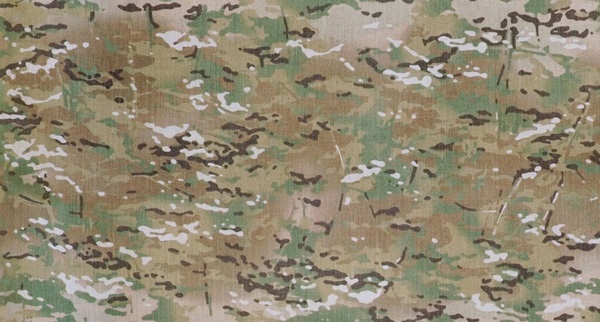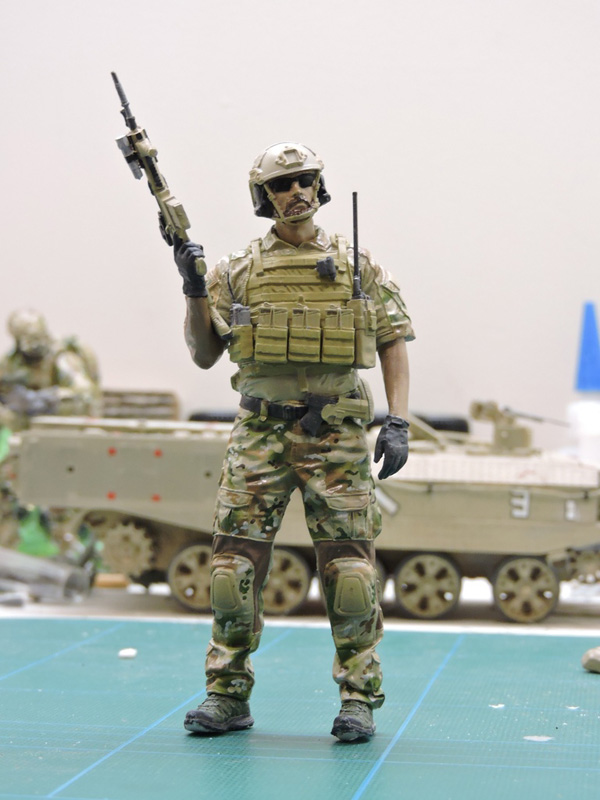1⁄16Painting Multicam Pattern
Multicam Made Easy in (almost) 4 Steps
When I first saw Multicam pattern on an uniform, it was already several years old, and that was a couple of years ago now. Back then, Multicam was in use almost exclusively with US Special Forces, before becoming the de rigour uniform of choice for the majority of armed forces around the world, which is a testament to the camouflage’s effectiveness. Multicam is made up of six colours, on two layers. The base layer consists of four colours, which are both ‘soft’ and ‘hard’ edged, whilst the top layer consists of “droppings” of two contrasting colours. The colours themselves are a dark brown, an earth brown, desert pink, khaki, medium green, and light grey. Thanks to militarymorons.com for this information. The purpose of this article is to document how I painted Multicam, and to demonstrate it is “do-able” in scale.
I studied multi-cam for hours to identify a pattern to it, and to decide how I’d paint it, as I was determined to apply this on a 1/16 figure (for this, I am using Airborne Miniature’s US SF Operator, with a focus on the trousers). To do this, I printed a colour A4 page of Multicam and just stared at it. Looking at one colour in isolation was easy, until it blended into the next. Whereby I hit on how to paint it.
I used Hobby Color H406 Chocolate brown (chocolate), H404 Khaki brown (khaki), H51 Light gull grey (grey), H44 Flesh (flesh), H43 Wood (wood), and Tamiya XF-5, Flat green (green).
The purpose of this article is to document how I painted Multicam, and to demonstrate it is “do-able” in scale.
I studied multi-cam for hours to identify a pattern to it, and to decide how I’d paint it, as I was determined to apply this on a 1/16 figure (for this, I am using Airborne Miniature’s US SF Operator, with a focus on the trousers). To do this, I printed a colour A4 page of Multicam and just stared at it. Looking at one colour in isolation was easy, until it blended into the next. Whereby I hit on how to paint it.
I used Hobby Color H406 Chocolate brown (chocolate), H404 Khaki brown (khaki), H51 Light gull grey (grey), H44 Flesh (flesh), H43 Wood (wood), and Tamiya XF-5, Flat green (green).
Step 1 - Preparation
Taking the figure, and cleaning it up ready for painting, I primed it using Tamiya Surface primer (L). I left to dry and harden over a couple of days.
I then painted it in a base colour of khaki, using my Tamiya High grade airbrush. As the base of Multicam is made up of four colours, you’re 25% of the way there already!
I also printed off a colour photograph of what it was I was trying to recreate in scale; in this case, Crye Precision combat pants, and pinned it to the wall above my workbench. I referred to this for scale and consistency of pattern.
Step 2 - Masking
Having laid down the first colour, the real work started for the second and subsequent colours: masking. For this, I used Bostik Blu-tack, which is cheap, reusable, and very flexible. Referring back to the pants image, I masked off where I’d want a hard edge to the next colour, and spraying in a random pattern for a soft edge. The beauty of the soft edge is that it diffuses both ways, blending two colours.
Masking is the key to Multicam, and between colours, you can move, remove, or leave the masking as you need, to achieve the desired result of a mix of hard and soft edged colours.
Again, referring back to the pants, I started to spray out the second colour, green, in carefully chosen areas. Every camouflage has a pattern, and Multicam is no exception, which is why I have the pattern pinned to my wall.
It is important to remember, this is only the second of four colours to apply, and it doesn’t need to cover the entire figure; equally important to remember, it does not need to be everywhere. There are large areas of the camo where there is no green. Or brown.
I left this to dry over a couple of days, before coming back to repeat this step for the next two colours: wood, and flesh. Always referring back to the pants and pattern images for scale and consistency. Again, applying, moving, or leaving the masking as needed.
Step 3 - Detailed painting
Once all four base colours are applied, the figure itself is covered in blu-tak, with little area of the base colour showing through. After the paint has dried, remove all the blu-tak, and prepare to move in with the brush. Referring back to the images, I prepared to apply detailed paint of the four base colours randomly, breaking up any large areas I may have missed, or wasn’t happy with.
Step 4 - Droppings
That done and dried, the next step is to apply the “droppings”: chocolate, and grey. Using a fine brush, I applied chocolate and grey randomly, whilst staying consist with the overall pattern of multi-cam; that is, the size, shape, and location of each.
Step 5 - Finishing
Having done all that, I completed painting of the figure with a wash from AK Interactive uniform range, using a dark brown glaze. And sealing it using Tamiya Flat clear, XF 86, applied with an airbrush.
Comments
 If you are talking about the pattern the US Army developed, OCP (Operational Camo Pattern), then it is mostly brown and green. It actually looks very similar to the old Woodland BDU pattern.
If you are talking about the pattern the US Army developed, OCP (Operational Camo Pattern), then it is mostly brown and green. It actually looks very similar to the old Woodland BDU pattern.
 It looks like the figure is actually wearing Cyre Multicam, not OCP.
It looks like the figure is actually wearing Cyre Multicam, not OCP.













